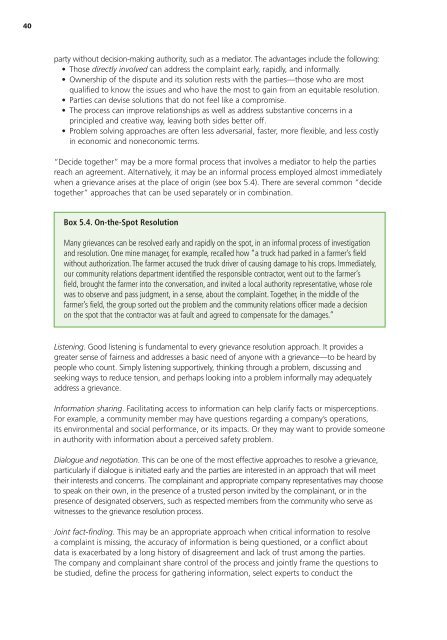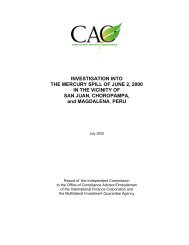A Guide to Designing and Implementing Grievance Mechanisms for ...
A Guide to Designing and Implementing Grievance Mechanisms for ...
A Guide to Designing and Implementing Grievance Mechanisms for ...
You also want an ePaper? Increase the reach of your titles
YUMPU automatically turns print PDFs into web optimized ePapers that Google loves.
40<br />
party without decision-making authority, such as a media<strong>to</strong>r. The advantages include the following:<br />
• Those directly involved can address the complaint early, rapidly, <strong>and</strong> in<strong>for</strong>mally.<br />
• Ownership of the dispute <strong>and</strong> its solution rests with the parties—those who are most<br />
qualified <strong>to</strong> know the issues <strong>and</strong> who have the most <strong>to</strong> gain from an equitable resolution.<br />
• Parties can devise solutions that do not feel like a compromise.<br />
• The process can improve relationships as well as address substantive concerns in a<br />
principled <strong>and</strong> creative way, leaving both sides better off.<br />
• Problem solving approaches are often less adversarial, faster, more flexible, <strong>and</strong> less costly<br />
in economic <strong>and</strong> noneconomic terms.<br />
“Decide <strong>to</strong>gether” may be a more <strong>for</strong>mal process that involves a media<strong>to</strong>r <strong>to</strong> help the parties<br />
reach an agreement. Alternatively, it may be an in<strong>for</strong>mal process employed almost immediately<br />
when a grievance arises at the place of origin (see box 5.4). There are several common “decide<br />
<strong>to</strong>gether” approaches that can be used separately or in combination.<br />
Box 5.4. On-the-Spot Resolution<br />
Many grievances can be resolved early <strong>and</strong> rapidly on the spot, in an in<strong>for</strong>mal process of investigation<br />
<strong>and</strong> resolution. One mine manager, <strong>for</strong> example, recalled how “a truck had parked in a farmer’s field<br />
without authorization. The farmer accused the truck driver of causing damage <strong>to</strong> his crops. Immediately,<br />
our community relations department identified the responsible contrac<strong>to</strong>r, went out <strong>to</strong> the farmer’s<br />
field, brought the farmer in<strong>to</strong> the conversation, <strong>and</strong> invited a local authority representative, whose role<br />
was <strong>to</strong> observe <strong>and</strong> pass judgment, in a sense, about the complaint. Together, in the middle of the<br />
farmer’s field, the group sorted out the problem <strong>and</strong> the community relations officer made a decision<br />
on the spot that the contrac<strong>to</strong>r was at fault <strong>and</strong> agreed <strong>to</strong> compensate <strong>for</strong> the damages.”<br />
Listening. Good listening is fundamental <strong>to</strong> every grievance resolution approach. It provides a<br />
greater sense of fairness <strong>and</strong> addresses a basic need of anyone with a grievance—<strong>to</strong> be heard by<br />
people who count. Simply listening supportively, thinking through a problem, discussing <strong>and</strong><br />
seeking ways <strong>to</strong> reduce tension, <strong>and</strong> perhaps looking in<strong>to</strong> a problem in<strong>for</strong>mally may adequately<br />
address a grievance.<br />
In<strong>for</strong>mation sharing. Facilitating access <strong>to</strong> in<strong>for</strong>mation can help clarify facts or misperceptions.<br />
For example, a community member may have questions regarding a company’s operations,<br />
its environmental <strong>and</strong> social per<strong>for</strong>mance, or its impacts. Or they may want <strong>to</strong> provide someone<br />
in authority with in<strong>for</strong>mation about a perceived safety problem.<br />
Dialogue <strong>and</strong> negotiation. This can be one of the most effective approaches <strong>to</strong> resolve a grievance,<br />
particularly if dialogue is initiated early <strong>and</strong> the parties are interested in an approach that will meet<br />
their interests <strong>and</strong> concerns. The complainant <strong>and</strong> appropriate company representatives may choose<br />
<strong>to</strong> speak on their own, in the presence of a trusted person invited by the complainant, or in the<br />
presence of designated observers, such as respected members from the community who serve as<br />
witnesses <strong>to</strong> the grievance resolution process.<br />
Joint fact-finding. This may be an appropriate approach when critical in<strong>for</strong>mation <strong>to</strong> resolve<br />
a complaint is missing, the accuracy of in<strong>for</strong>mation is being questioned, or a conflict about<br />
data is exacerbated by a long his<strong>to</strong>ry of disagreement <strong>and</strong> lack of trust among the parties.<br />
The company <strong>and</strong> complainant share control of the process <strong>and</strong> jointly frame the questions <strong>to</strong><br />
be studied, define the process <strong>for</strong> gathering in<strong>for</strong>mation, select experts <strong>to</strong> conduct the





